Mushrooms
Media

Species Types
Scientific Name
Pleurotus ostreatus and P. pulmonarius
Description
Oyster mushrooms are choice edibles with broad, fleshy, whitish, grayish, or tan caps and a stubby, off-center stalk. They grow clustered on stumps, logs, and trunks.
Media

Species Types
Scientific Name
Daedaleopsis confragosa (Daedalea confragosa)
Description
The thin-maze flat polypore is a grayish brown bracket fungus with a zoned top and a furrowed, mazelike underside. It grows singly or in small, layered clusters on dead wood or in wounds of living trees.
Media
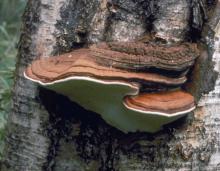
Species Types
Scientific Name
Ganoderma applanatum
Description
The artist conk is a woody, semicircular, brownish bracket with a white underside that bruises dark gray to black. It grows on dead wood or in wounds of living deciduous trees.
Media
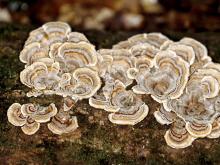
Species Types
Scientific Name
Trametes versicolor
Description
Turkey tail grows in clusters of leathery, thin brackets with multicolored zones above and whitish yellow pores below. Look for it on stumps and logs of deciduous trees.
Media

Species Types
Scientific Name
Trichaptum biforme
Description
The violet toothed polypore is a bracket fungus with tough, hairy caps with violet margins and zones of white, brown, and black; beneath, the whitish violet pores break into teeth. It grows on stumps and logs of deciduous wood.
Media
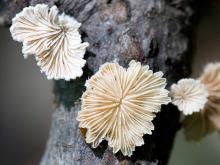
Species Types
Scientific Name
Schizophyllum commune
Description
Split gills grow in clusters with small, white, hairy, fan-shaped caps. Beneath, they have whitish or pinkish gill-like folds that split toward the edge. They grow on dead branches of deciduous trees.
Media
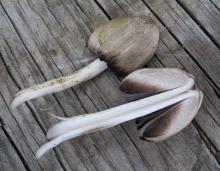
Species Types
Scientific Name
Coprinopsis atramentaria (formerly Coprinus atramentarius)
Description
The alcohol inky has a gray-brown, bell-shaped, radially lined cap and inky gills. It grows in clusters on the ground, usually near rotting or buried wood.
Media

Species Types
Scientific Name
Amanita spp. (about 600 species, worldwide)
Description
This large group of mushrooms accounts for 90 percent of mushroom-related deaths, so every mushroom hunter should be familiar with amanitas. They contain one of the deadliest poisons found in nature!
Media
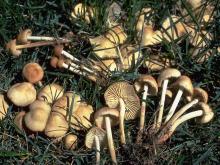
Species Types
Scientific Name
Marasmius oreades
Description
The fairy ring mushroom has a tan to reddish brown, knobbed cap with off-white gills. It grows in grassy areas, lawns, meadows, often in circles called fairy rings.
Media

Species Types
Scientific Name
Pluteus atricapillus (formerly P. cervinus)
Description
The fawn mushroom has a brownish gray cap with whitish to pinkish gills and a whitish stalk. It grows singly or scattered, on dead wood or on the ground over buried wood.
See Also



Media

Species Types
Scientific Name
Monotropa hypopitys
Description
Pinesap is a plant that puts the "wild" in wildflower! It lacks chlorophyll, so its roots connect to fungi underground and absorb nutrients from the fungi.
Media

Species Types
Scientific Name
Cladophora, Pithophora, and Spirogyra spp., and others
Description
Filamentous green algae forms green, cottony masses that are free-floating or attached to rocks, debris, or other plants.
Media

Species Types
Scientific Name
Monotropa uniflora
Description
Indian pipe lacks chlorophyll, so it is white, not green. Below ground, its roots join with fungi that connect to tree roots. This plant, then, takes nourishment indirectly from the trees.
About Mushrooms in Missouri
Mushrooms are a lot like plants, but they lack chlorophyll and have to take nutrients from other materials. Mushrooms are neither plants nor animals. They are in a different kingdom — the fungi. Fungi include the familiar mushroom-forming species, plus the yeasts, molds, smuts, and rusts.
Always be cautious when eating edible mushrooms. Be absolutely sure of the ID, and only eat a small amount the first time you try it to avoid a reaction..





















